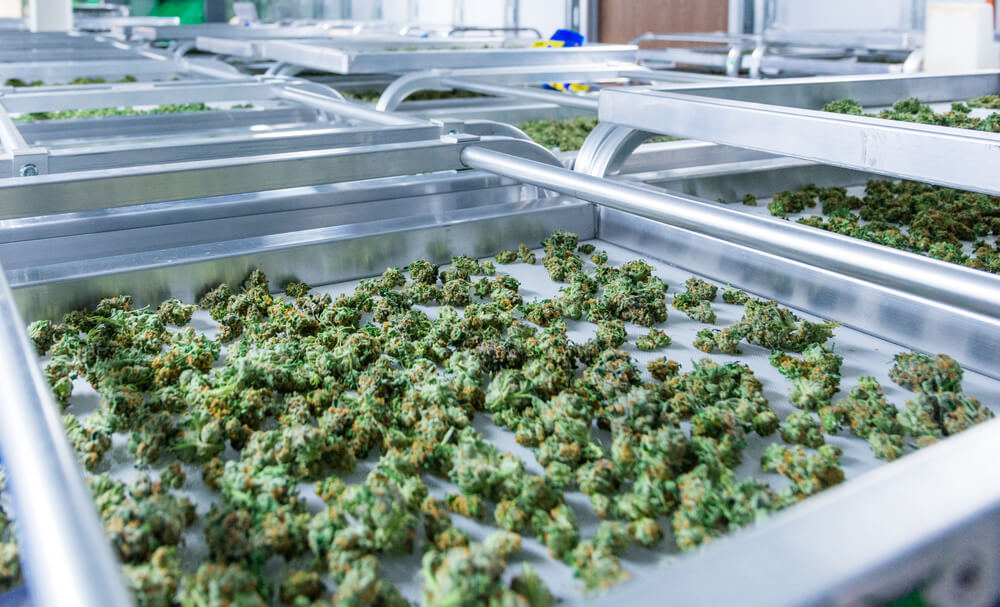Since marijuana is well on its way to becoming fully legalized, we figured it was high time to give you the tools and know-how on how to grow weed at home.
The most primitive method for growing marijuana — the great outdoors — is the most efficient approach if your goal is to have some weed on hand to enjoy occasionally. If your goal is to grow enormous buds from the comfort of your own home, you’ll want to opt for an indoor grow room.
While growing cannabis is a bit more complex than the average vegetable, it isn’t by much. But before we get carried away about how to grow weed, it is imperative that you familiarize yourself with the local marijuana laws governing your province.
Tools of the Cannabis Growing Trade

Like any good pioneer, before embarking on your growing journey you’re going to need materials. Keep in mind they don’t have to be the most expensive or the fanciest thing on the market; in fact, it’s relatively inexpensive to grow marijuana.
Common sense would dictate that the first order of business is to determine a space. It should be large enough to house the amount of weed you’re intending on growing. We recommend investing in a quality tent that is large enough for your grow op.
Once you have your grow room established, you need to invest in good grow lights, also known as glowlights. An MH system with ballasts, bulbs, and reflectors, a HID glow light, or HPS light will work, but it’s important to remember to keep an eye on how much heat the lights generate because it could ruin the crop.
This is why an exhaust fan is also required for a proper setup — it dissipates extra heat, keeps air from becoming stagnant, and removes odors at the same time. There are plenty of options available in stores and online. Additionally, you’ll want to get a thermometer and a hygrometer to keep track of the temperature and humidity.
Now, you can’t grow marijuana without seeds. If you don’t have access to seeds or clones locally — you can order them online.
You’ll also need to get 3-5 gallons worth of loose soil, preferably organic; making sure to keep it loose. You should also invest in high-quality nutrients that are well-reviewed by a popular brand to ensure your plants are getting everything they need to grow.
If using a bucket, cut holes in the bottom and place a tray or saucer beneath it to catch any spillage and overflow.
How to Grow Weed at Home

Now that we got the technicalities out of the way, now comes the fun part! Before planting your seeds, you’ll want to root (germinate) them in a damp paper towel first.
Once the seeds are rooted (the roots are showing), you can now plant your seeds in the soil, making sure to give them adequate light that doesn’t crank up the temperature or suck out the moisture.
When your marijuana plant hits the vegetative state, it will begin to sprout lots of leaves and branches, but it shouldn’t flower yet — unless it’s an auto-flowering seed.
Regardless of the type of seed, the most important points to remember are that the lights are not too hot, there is plenty of fresh air flow, water and dedication to being vigilant.
If you’re growing indoors, it’s imperative that you have proper control of these growing conditions as failure to do so will result in lower quality and lower quantity yields.
If you want more tips on how to grow weed easy check our guide.
Beware of Overwatering and Overfeeding
While we don’t commonly associate plants with being overfed and watered, it can and does happen. To find out, look at the leaves: if they look droopy, they’re getting over-watered. If they look burnt, they are getting too many nutrients.
The Vegetative Stage
This phase of growth occurs before flowering and after germination. At this point, the plant will not produce any buds — just stems and leaves — but it will grow like a weed, no pun intended.
Your two main jobs now are to keep them watered and check the pH levels to prevent nutrition issues like build-up or malnourishment. In terms of supplemental nutrient dosing, you can use the recommended amount for “vegetative” growth, but it is usually a good idea to begin at half-strength since the recommendations have been known to be too strong.
At this stage, you’ll also want to ensure that your rapidly growing plants are far enough away from the lights to prevent overheating or burning them.
Flowering Stage
The flowering phase is the most important stage of the cannabis growing process. This is done after the plants reach the desired size during the vegetative phase, and it has to be induced by the grower by implementing 12 hours off and 12 hours on light cycle.
Once it’s induced, you’ll also need to increase the plant’s nutrients to encourage and support bud growth. Your plants will thank you.
Curing, Drying And Harvesting

Knowing when to harvest weed is as important as knowing how to grow it. The simplest way of doing this is to use a magnifying glass and look at the small glass-like crystals known as trichomes.
This is where all the cannabinoids (THC, CBD) and terpenes of the plant are found. When these trichomes go from clear to cloudy white, it’s time to harvest. If you wait until they all turn an amber color, you’ve waited too long.
Before harvesting, it’s important to “flush” your plants. This means running water through the soil your flowers are planted in. Run water that has a neutral ph (5.5 – 6.8) into your soil until it’s fully saturated.
You’ll want to do this 2 weeks before harvest if you’re using soil and 1 week before harvest if you’re using hydroponics.
After harvesting the buds, they need to be trimmed and dried, which can take about a week depending on humidity levels and the time of year. Curing cannabis is important to ensure the cannabis is safe and pleasant to consume and at the highest potency. To do this, make sure the stem of the bud has enough moisture and flexibility it can bend, but the leaves should be bone dry.
Once your cannabis is dried, then the trimming of the rest of the sugar leaves can take place. Properly trimming weed ensures that the bud can ‘breath’ better, leading to better curing and better smoking experience.
Once you can guarantee your buds are properly cured and dry — they can be packaged and are ready to enjoy!
Closing Thoughts on How to Grow Weed
It’s a bit of a convoluted process to start growing your own weed but if you’re only looking to grow a few plants for private consumption, then you’ll be more than able to successfully harvest a large and potent yield. Try organizing each day through a planner and keeping track of the steps you take each day to care for your plants. You might find that it only takes 10-20 minutes a day to keep up!
Looking for more tips on how to grow weed at home? Check out our guide to Space Bucket.

